Home > News > The Prime Minister in Action > August 2012 > The Prime Minister Attends the Nagasaki Peace Memorial Ceremony, and Other Activities
The Prime Minister Attends the Nagasaki Peace Memorial Ceremony, and Other Activities
Thursday, August 9, 2012
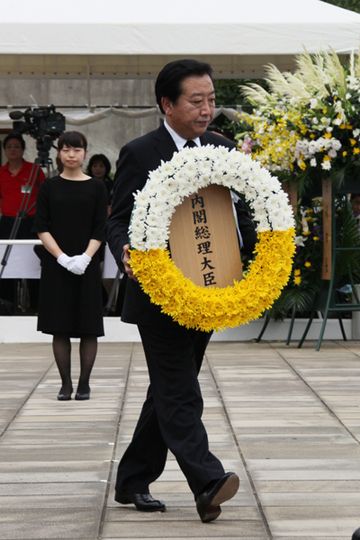
Photograph of the Prime Minister offering flowers at the Nagasaki Peace Memorial Ceremony

Photograph of the Prime Minister observing Shiroyama Elementary School in Nagasaki City
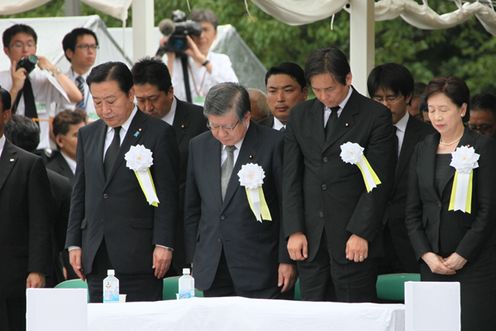
Photograph of the Prime Minister offering a silent prayer at the Nagasaki Peace Memorial Ceremony
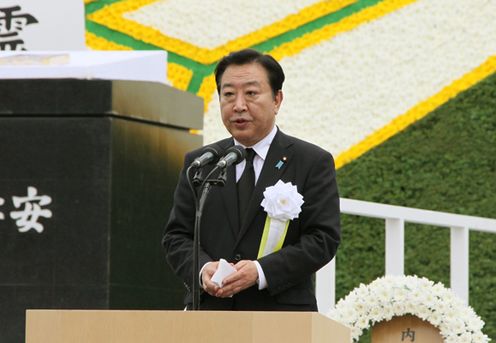
Photograph of the Prime Minister delivering an address at the Nagasaki Peace Memorial Ceremony 1
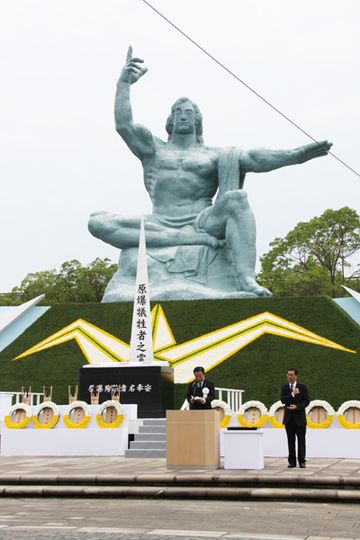
Photograph of the Prime Minister delivering an address at the Nagasaki Peace Memorial Ceremony 2
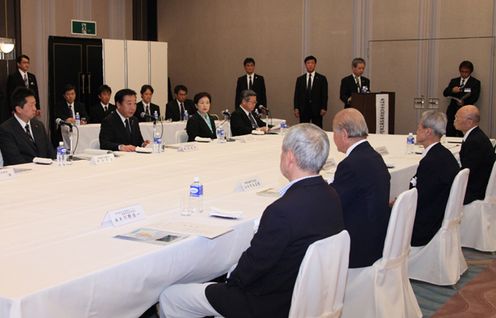
Photograph of the Prime Minister delivering an address at the Meeting to Listen to Requests by Representatives of Atomic Bomb Victims
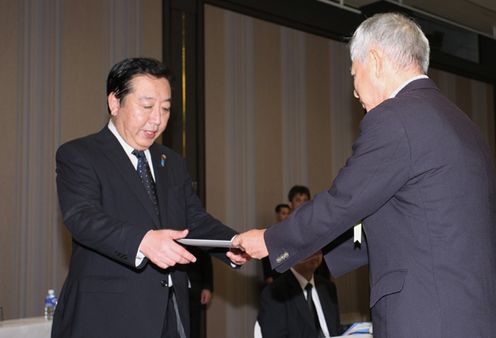
Photograph of the Prime Minister receiving a letter of request from atomic bomb victims’ organizations

Photograph of the Prime Minister at a press conference

Photograph of the Prime Minister visiting a nursing home for atomic bomb survivors in Nagasaki, the Hill of Grace Nagasaki A-Bomb Home 1
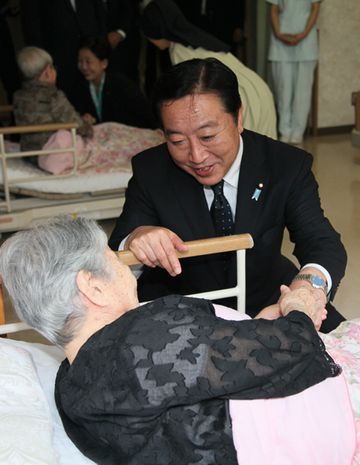
Photograph of the Prime Minister visiting a nursing home for atomic bomb survivors in Nagasaki, the Hill of Grace Nagasaki A-Bomb Home 2
Prime Minister Yoshihiko Noda attended the annual Nagasaki Peace Memorial Ceremony held in the Peace Park in Nagasaki City.
After arriving in Nagasaki City, the Prime Minister visited Shiroyama Elementary School in Nagasaki City, which is nearest to the epicenter of the atomic bomb and suffered severe damage, and observed the bombed school building that is now on exhibit as a peace memorial hall before the ceremony.
Approximately 5,900 people including atomic bomb victims and bereaved family members, as well as representatives of 41 nations and the European Union, attended the ceremony marking the 67th anniversary of the atomic bombing, praying for the repose of the souls of the war dead. This was also the first time that ambassadors of the United States, United Kingdom and the French Republic attended the ceremony.
Mr. Tomihisa Taue, Mayor of Nagasaki City, and the representatives of the bereaved family members and the atomic bomb victims placed at the site the list of the names of the atomic bomb victims who had been confirmed dead in the past year. The representatives of the bereaved family members, the atomic bomb victims, and the local elementary, junior high, and high school students offered water. Mayor Taue, Prime Minister Noda, and other guests then offered wreathes.
The Bell of Nagasaki was rung at 11:02 a.m., when the atomic bomb was dropped, and the participants prayed in silence for a minute. Following Mayor Taue's Peace Declaration, the recital of the Promise for Peace by Mr. Masanori Nakashima, the representative of the atomic bomb victims, and the choral singing by students from Yamazato Elementary School in Nagasaki City, Prime Minister Noda delivered an address.
The Prime Minister said, "Humankind must never forget the horror of nuclear weapons. Nor must the tragedy that unfolded in Nagasaki and is etched in annals of human history ever be repeated. As the only country to have experienced the horror of nuclear devastation in war, Japan bears a noble and grave responsibility to all of humankind and to the future of our planet. That responsibility is to pass on the memories of our tragic experiences to future generations and to see to it that the passion and desire for action to realize 'a world without nuclear weapons' spreads around all over the world.
Today, 67 years on from the atomic bombing of Nagasaki, on behalf of the Government of Japan, I pledge that Japan will observe its Constitution and firmly maintain the Three Non-Nuclear Principles for the sake of the ultimate elimination of nuclear weapons and the realization of eternal world peace.
With the passage of 67 years, those people who can speak directly about their experiences of the atomic bombing are now advanced in years. We are reaching a stage of critical importance in historical terms with regard to passing on the experiences of the atomic bombing.
Disarmament and non-proliferation education is of the greatest importance as a social foundation from which to renew and refresh memories. Those who implement such education need not necessarily be limited to the public sector. Already a wide range of bodies are engaged in diligent activities, including research and educational institutions, non-governmental organizations (NGO) and the media. Above all, we should always remember that the direct actions of the people of Nagasaki themselves provide a significant driving force. I would like to express my appreciation once again to all of the 'Special Communicators for a World without Nuclear Weapons' for their activities of travelling to 49 locations around the world to share the experiences of Nagasaki with people overseas. The Government of Japan will continue to highlight the importance of 'a world without nuclear weapons' and will push forward with various kinds of efforts to ensure that memories of Japan's atomic bomb experiences are passed on, both across national borders and across generations."
The Prime Minister also said, "More than one year has passed since the Great East Japan Earthquake and the accident at Tokyo Electric Power Company's Fukushima Daiichi Nuclear Power Station. Many people from Nagasaki have devoted themselves to the rebirth of Fukushima and have provided various kinds of assistance. The Government will spare no effort in the rebuilding of infrastructure for daily life, including decontamination operations, to ensure that the residents of Fukushima who are still enduring discomfort and inconvenience in their everyday activities can return to their normal daily lives as soon as possible. Furthermore, we aim to establish an energy structure in the mid to long term in a form that will be reassuring for the people of Japan, under a basic policy of reducing our dependence on nuclear power."
After the ceremony, the Prime Minister attended the Meeting to Listen to Requests by Representatives of Atomic Bomb Victims, at a hotel in Nagasaki City, and heard requests from representatives from five groups of atomic bomb victims and others, followed by a press conference.
Afterwards, the Prime Minister visited a nursing home for atomic bomb survivors in Nagasaki, the Hill of Grace Nagasaki A-Bomb Home.









